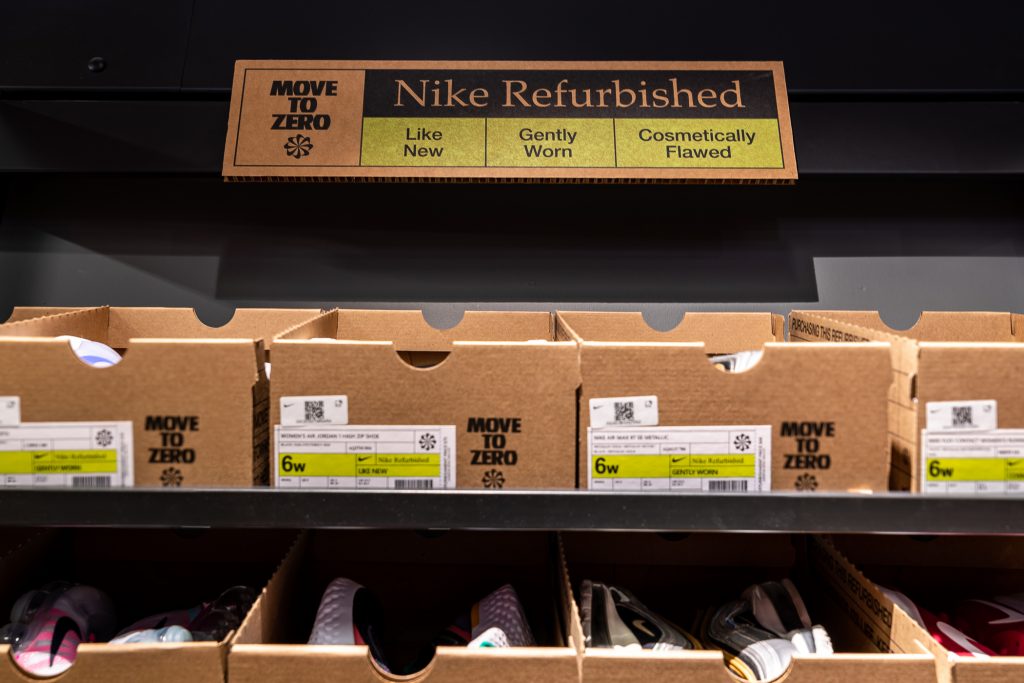Environment & Nature
How Nike Helps You Help the Planet

For 50 years, Nike’s been innovating its products so athletes* can perform at their best. With climate change being an even more urgent threat, innovation also means eliminating waste from products, making sustainably minded changes to production, and driving toward a circular future to protect our planet. Nike can’t do that alone. Recognizing the unique role its consumers are playing, the company is inviting them to join the effort, empowering responsible choices — from the products they buy to extending the life of the gear they already own.
* Nike’s mission states, “If you have a body, you are an athlete.”
One: Nike Refurbished offers a way to shop smarter and with sustainability in mind; Repair In-Store helps extend the life of treasured products.

With Nike Refurbished, each pair of eligible footwear is inspected and refurbished by hand before being given an inspection grade.
Lightly worn AF1s or gently used Jordans aren’t brand-new, but that doesn’t mean they’re ready to be trashed. Nike sees great potential in the nuance between new and old. In North America, the Nike Refurbished program takes back footwear from athletes and manually sorts it into three categories: gently worn, like new or slightly imperfect. Nike refurbishes the shoes by hand and offers consumers the opportunity to buy the retooled shoes.
Two: Recycling & Donation (RAD), another Nike Sustainability program, provides a way to get more use out of products.

…remove the elements that can’t be recycled…

…and then prepare the footwear to be converted into Nike Grind. If the shoes are still usable, they will be donated to communities in need.

Recycling & Donation allows you to pass along your pair of beloved AF1s at a participating Nike store…

…where a Nike Store athlete will personally inspect your shoe…

…remove the elements that can’t be recycled…

…and then prepare the footwear to be converted into Nike Grind. If the shoes are still usable, they will be donated to communities in need.

Recycling & Donation allows you to pass along your pair of beloved AF1s at a participating Nike store…

…where a Nike Store athlete will personally inspect your shoe…
In 2021, Nike launched Recycling & Donation — a way for consumers to pass on their gear to be recycled or donate it to communities in need — in stores across Europe, including doors in France, Spain, Italy, the Netherlands, Germany and Poland (it’s recently been scaled to stores in Asia too). Recycling & Donation is an evolution of Nike’s global Reuse-a-Shoe program, which began in 1992 as a pioneering in-store service that converted previously owned shoes into Nike Grind, a versatile recycled material. One giant step forward for Recycling & Donation: The service accepts not only athletic footwear, but athletic apparel too. This progress builds toward Nike’s 2025 target to donate, refurbish or recycle 10 times more product than it did in 2020.
Three: Nike.com has a cache of product-care guides to help you clean, repair and get more use out of cherished gear.
Not near a Nike store with a refurbishing program? Check out the simple product-care tutorials on Nike.com to help extend the life of your go-to shoes and apparel and find out where and how to donate or recycle them responsibly.
Four: Nike Grind, one of the company’s most innovative sustainable materials, can be found in products across industries. This means more items on your shopping list are made from cleaner materials.

Nike Grind was once a smaller grassroots initiative before it was officially coined in 1992 —an example of how Nike is scaling small ideas to create positive impact for the planet.
Now in its 30th year, Nike Grind, a material made from manufacturing scrap and end-of-life footwear, is such a high-quality feedstock that it appears in other companies’ products. That includes commercially sold gym tiles, made up of at least 37% Nike Grind. In the 2021 fiscal year alone, this single product recycled more than 750,000 pounds of rubber waste. You’ll see Nike Grind transformed into playground turf and and running tracks, along with phone cases, carpet padding and furniture. The material is a near supercompound in its ability to transcend industries, helping more businesses shrink their environmental footprint.
Five: Nike is creating even more opportunities to shop with purpose by making products with a higher percentage of sustainable materials and methods — including pinnacle performance shoes and iconic silhouettes.
In its 2021 fiscal year, Nike increased its use of recycled polyester in apparel by 12 percent, and recycled poly makes up 38 percent of its total polyester usage in footwear, double what was used in the previous year. You see thoughtful changes like this across the spring/summer 2022 Move to Zero collections, where examples of sustainable design merge in a huge range of products, from Windrunner jackets to Nike Pro shorts to Air Maxes and Dunks. These efforts help Nike get closer to its 2025 sustainability targets, like putting at least 80 percent of Nike’s extended supply chain waste back into new products.





















